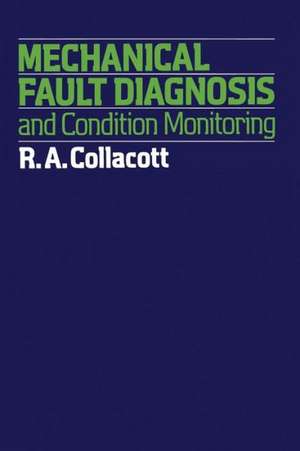Mechanical Fault Diagnosis and condition monitoring
Autor R. Collacotten Limba Engleză Paperback – 5 noi 2011
Preț: 902.59 lei
Preț vechi: 1100.72 lei
-18% Nou
Puncte Express: 1354
Preț estimativ în valută:
172.71€ • 180.32$ • 142.94£
172.71€ • 180.32$ • 142.94£
Carte tipărită la comandă
Livrare economică 04-18 aprilie
Preluare comenzi: 021 569.72.76
Specificații
ISBN-13: 9789400957251
ISBN-10: 9400957254
Pagini: 512
Ilustrații: X, 496 p.
Dimensiuni: 155 x 235 x 30 mm
Greutate: 0.78 kg
Ediția:Softcover reprint of the original 1st ed. 1977
Editura: SPRINGER NETHERLANDS
Colecția Springer
Locul publicării:Dordrecht, Netherlands
ISBN-10: 9400957254
Pagini: 512
Ilustrații: X, 496 p.
Dimensiuni: 155 x 235 x 30 mm
Greutate: 0.78 kg
Ediția:Softcover reprint of the original 1st ed. 1977
Editura: SPRINGER NETHERLANDS
Colecția Springer
Locul publicării:Dordrecht, Netherlands
Public țintă
ResearchCuprins
1 Failure types, investigation and occurrences.- 1.1 Introduction.- 1.2 System failure and component failure.- 1.3 Failure decisions.- 1.4 Failure classifications.- 1.5 Types of failure.- 1.6 Failure investigations.- 1.7 Failure case studies.- 1.8 Human factors in failure incidents.- 2 Causes of failure.- 2.1 Introduction.- 2.2 Service failures.- 2.3 Fatigue.- 2.4 Excessive deformation.- 2.5 Wear.- 2.6 Corrosion.- 2.7 Blockage, sludges.- 2.8 Blockage in cooling systems.- 2.9 Design, manufacturing and assembly causes of failure.- 3 Fault detection sensors.- 3.1 Introduction.- 3.2 Contaminant monitoring.- 3.3 Corrosion monitoring.- 3.4 Force monitoring.- 3.5 Gas leakage monitoring.- 3.6 Air pollution monitoring.- 3.7 Liquid contamination monitoring.- 3.8 Non-destructive testing techniques.- 3.9 Optical examination.- 3.10 Temperature sensing.- 3.11 Particle testing.- 3.12 Proximity monitors.- 3.13 Sound monitoring.- 3.14 Vibration transducers.- 3.15 Telemetry.- 4 Data processing and analysis.- 4.1 Introduction.- 4.2 Fourier analysis.- 4.3 Frequency analysis techniques.- 4.4 Derived functions.- 5 Vibration analysis.- 5.1 Introduction.- 5.2 Vibration-simple harmonic motion concept.- 5.3 Vibration signature of active systems.- 5.4 Vibration monitoring equipment.- 5.5 System monitors and vibration limit detectors.- 5.6 Vibration monitoring experience.- 5.7 Critical vibration levels.- 6 Sound monitoring.- 6.1 Introduction.- 6.2 Sound frequencies.- 6.3 Sound loudness measurement.- 6.4 Acoustic power.- 6.5 Sound measurement.- 6.6 Magnetic tape recorders.- 6.7 Sound level meters.- 6.8 Sound analysers.- 6.9 Sound signal data processing.- 6.10 Sound monitoring.- 7 Discrete frequencies.- 7.1 Introduction.- 7.2 Simple vibrations.- 7.3 Transverse vibrations of bars — approximatefrequency calculations.- 7.4 More precise evaluations — overtones.- 7.5 Torsional oscillation of flywheel-bearing shafts.- 7.6 Belt drives.- 7.7 Whirling of marine line shafting.- 7.8 Gear excitation.- 7.9 Rolling element bearing.- 7.10 Blade vibration.- 7.11 Cam mechanism vibration.- 8 Contaminant analysis.- 8.1 Introduction.- 8.2 Contaminants in used lubricating oils.- 8.3 Carrier fluid degradation.- 8.4 Contaminant monitoring techniques (wear processes).- 8.5 Oil degradation analysis.- 8.6 Abrasive particles in lubricating oil.- 8.7 Abrasive particles in bearings.- 8.8 Abrasive particles in hydraulic systems.- 8.9 Dissolved gas fault monitoring.- 9 SOAP and other contaminant monitoring techniques.- 9.1 Introduction.- 9.2 Spectrometric oil analysis procedure.- 9.3 Magnetic chip detectors.- 9.4 ‘Ferrograph’ particle precipitation.- 9.5 STM control kit.- 9.6 Used oil blotter test.- 9.7 Thin-layer chromatography.- 9.8 Capacitative oil debris monitor.- 9.9 X-ray fluorescence detection of contamination (XRF).- 9.10 X-ray photoelectron spectrometry.- 9.11 Particle classification.- 10 Performance trend monitoring.- 10.1 Primary monitoring - performance.- 10.2 Primary and secondary performance parameters.- 10.3 Performance trend analysis.- 10.4 Turbine gas path performance monitoring thermodynamics.- 10.5 Steam turbine performance analysis.- 10.6 Case studies in performance monitoring.- 10.7 Performance monitoring systems.- 11 Static testing.- 11.1 Introduction.- 11.2 Visual testing.- 11.3 Liquid penetrant inspection.- 11.4 Thermal methods.- 11.5 X-ray photography.- 11.6 Sonics.- 11.7 Ultrasonics.- 11.8 Stress wave emission.- 11.9 Magnetic testing methods.- 11.10 Electrical NDT techniques.- 11.11 Eddy current testing.- 11.12 NDT selection.- 12 Monitoring systems inoperation.- 12.1 Introduction.- 12.2 Marine monitoring systems.- 12.3 Marine condition monitoring requirements.- 12.4 Marine diesel engine monitoring.- 12.5 Marine turbine monitoring systems.- 12.6 Shipboard vibration monitoring.- 12.7 Spectrometric oil analysis programme — marine.- 12.8 Monitoring integrity verification.- 12.9 Aircraft condition monitoring.- 12.10 Condition monitoring — generating plant.- 12.11 Automotive diagnostic equipment.- 12.12 Systematic fault monitor selection.- 13 Fault analysis planning and system availability.- 13.1 Introduction.- 13.2 Availability.- 13.3 Failure prediction/reliability assessment.- 13.4 Hazard rate curve.- 13.5 Complex system reliability — Monte Carlo simulation.- 13.6 Hazardous chemical plants — high integrity protective systems (HIPS).- 14 Reliability/failure concepts.- 14.1 Introduction.- 14.2 Probability of reliability and failure.- 14.3 Failure pattern-exponential distribution.- 14.4 Load and strength — statistical distribution.- 14.5 Reliability assurance — BS 9000 system.- 15 Reliability data sources.- 15.1 Introduction.- 15.2 Systems Reliability Service (SRS).- 15.3 Failure data.- 15.4 Environmental influences on instrument failure rates.- 15.5 Failure data—confidence level.


